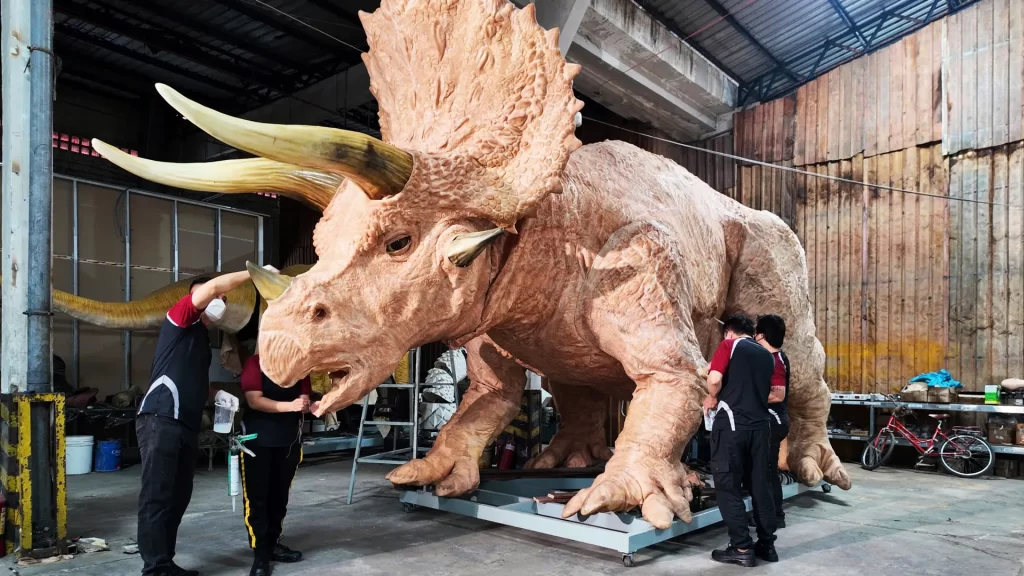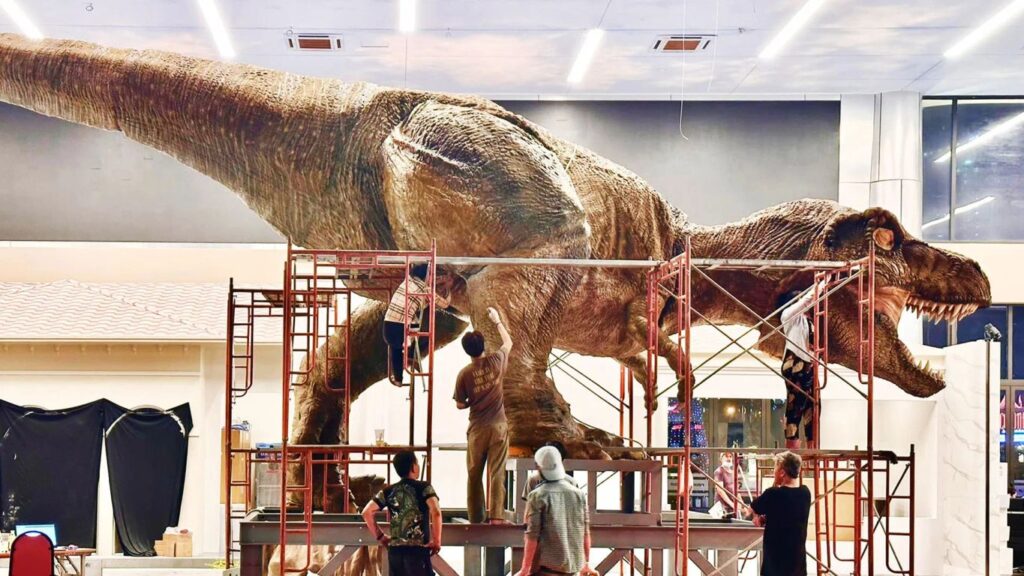Animatronics have become a fascinating part of modern entertainment and technology, but many people wonder: Are animatronics dangerous? This article aims to explore the intricacies of animatronics, from their construction to their safety measures, and help you understand the real risks and benefits associated with these robotic creations.
Key Takeaways
- Animatronics are complex machines designed for entertainment and educational purposes.
- While there are risks, modern animatronics come equipped with numerous safety features.
- Industry standards play a significant role in ensuring animatronic safety during operation.
- Public perception of animatronics varies, often mixing fear with fascination.
- The future of animatronics looks promising with ongoing innovations and sustainability efforts.
Understanding Animatronics Technology
Animatronics are way more than just cool robots; they’re a blend of art and engineering that brings inanimate objects to life. Let’s break down what makes them tick.
What Are Animatronics?
Animatronics are essentially advanced puppets powered by mechanics, electronics, or even pneumatics to simulate life. Think of the dinosaurs in “Jurassic Park” or the characters at Disney theme parks. They’re designed to look and move like real creatures or people, creating believable illusions. The goal is to suspend disbelief and immerse audiences in a story or experience.

What Are Animatronics?
Animatronics differ from regular robots in a few key ways:
- Focus on Realism: Animatronics prioritize realistic appearance and movement over functionality.
- Complex Articulation: They often have many points of articulation to mimic natural motion.
- Aesthetic Design: A lot of work goes into making them look convincing, with detailed skin, fur, and features.
How Are Animatronics Built?
Building an animatronic is a complex process that involves several stages:
- Design and Conceptualization: It starts with a concept, sketches, and detailed plans. This includes figuring out the range of motion, the materials needed, and the overall look.
- Frame Construction: A strong internal frame, usually made of metal or strong plastic, provides the structure and support for all the moving parts.
- Actuation Systems: These are the muscles of the animatronic. They can be electric motors, hydraulic cylinders, or pneumatic systems that control movement.
- Skin and Detailing: The outer layer is crafted from materials like silicone, foam latex, or urethane to create a realistic appearance. This involves sculpting, molding, and painting to add details like wrinkles, textures, and colors.
- Control Systems: These systems coordinate the movements of the animatronic. They can range from simple remote controls to sophisticated computer programs that allow for complex, lifelike actions. For example, animatronic dinosaurs require complex systems to mimic realistic movement.
The Role of Robotics in Animatronics
Robotics plays a big role in modern animatronics, adding layers of sophistication and realism. Here’s how:
- Precise Movements: Robotics allows for very precise and repeatable movements, which is important for creating believable actions.
- Complex Programming: Robotic systems can be programmed to perform complex sequences of movements, making animatronics more lifelike and responsive.
- AI Integration: Some animatronics now use artificial intelligence to react to their environment and interact with people in a more natural way. This could involve responding to voice commands or adapting to changes in lighting or sound.
Cinemagic Workshop is at the forefront of integrating robotics into animatronics. Their team combines artistic talent with engineering skills to create animatronics that are not only visually stunning but also incredibly lifelike in their movements. They focus on craftsmanship and attention to detail, ensuring that each creation meets the highest standards of quality and safety.
Animatronics are constantly evolving, with new materials, technologies, and techniques being developed all the time. Companies like Cinemagic Workshop are pushing the boundaries of what’s possible, creating increasingly realistic and engaging experiences for audiences around the world. They are known for their innovative animatronics and commitment to quality.
Evaluating Safety Concerns
Potential Risks of Animatronics
Okay, let’s talk about the elephant in the room: Are animatronics dangerous? Well, like any complex machine, there are potential risks. Think about it – these things often involve powerful motors, hydraulics, and intricate wiring. A malfunction could lead to unexpected movements or even component failures. It’s not like they’re inherently out to get you, but you’ve got to respect the potential for things to go wrong. For example, a sudden, jerky motion could cause injury if someone is too close. Also, electrical faults could pose a hazard if not properly managed. That’s why regular maintenance and inspections are super important.

Regular maintenance and inspection of Animatronics is extremely important
Safety Features in Modern Animatronics
Thankfully, modern animatronics are designed with a ton of safety features. These features are there to minimize risks and protect both operators and audiences. Here’s a quick rundown:
- Emergency stops: These are crucial for quickly shutting down the animatronic in case of a problem.
- Motion sensors: These can detect when someone gets too close and trigger a stop or alter the animatronic’s movements.
- Safety cages and barriers: Physical barriers help keep people at a safe distance.
- Regular inspections: Catching potential problems before they become real issues.
It’s important to remember that safety isn’t just about the hardware. Proper training for operators is key. They need to know how to handle the animatronic, recognize potential hazards, and respond effectively in an emergency.
Industry Standards for Safety
There are actually industry standards in place to ensure animatronics are built and operated safely. Organizations like ASTM International have guidelines that cover everything from design and manufacturing to operation and maintenance. These standards help ensure a consistent level of safety across the industry. Cinemagic Workshop is committed to not only meeting but exceeding these standards. We believe in safe animatronic manufacturing and that starts with rigorous testing and quality control. We also work closely with our clients to educate them on the safe use of our products. It’s all about building trust and ensuring everyone can enjoy the magic of animatronics without unnecessary risk. We also focus on quality assurance processes to ensure the safety of our products.
Real-World Applications of Animatronics
Animatronics aren’t just cool robots; they’re finding their way into all sorts of places you might not expect. From bringing dinosaurs back to life to helping kids learn, these creations are making a real impact.
Entertainment and Theme Parks
Theme parks are probably the first place most people think of when they hear “animatronics,” and for good reason. They’re a staple! Think about it: lifelike pirates, singing bears, and even massive dinosaurs. These aren’t just static figures; they move, talk, and interact with guests, creating immersive experiences that make these parks unforgettable. Animatronics bring stories to life in a way that nothing else can.
- Creating realistic characters for rides and shows.
- Enhancing the overall atmosphere and immersion of themed areas.
- Allowing for dynamic and interactive performances.
Animatronics in entertainment are constantly evolving. The goal is always to create something that blurs the line between reality and fantasy, making the experience as believable and engaging as possible for the audience.
Education and Workshops
Believe it or not, animatronics are also making their way into education. Imagine learning about robotics by building your miniature animatronic creature! That’s exactly what’s happening in some schools and workshops. These hands-on experiences can teach kids about engineering, programming, and even art, all while having a blast. SPARK-E is a great example of a programmable animatronic kit designed for K-12 education.
- Providing hands-on learning experiences in STEM fields.
- Encouraging creativity and problem-solving skills.
- Making complex topics like robotics more accessible and engaging.
Medical and Therapeutic Uses
This is where things get interesting. Animatronics are being used in some pretty innovative ways in the medical field. For example, they can be used to create realistic training dummies for surgeons, allowing them to practice complex procedures in a safe environment. There’s even research being done on using animatronic animals to help children with autism develop social skills. It’s amazing to see how animatronics are modern adaptations of automatons and can be used to improve lives.
- Creating realistic surgical training models.
- Developing therapeutic tools for children with special needs.
- Assisting in patient rehabilitation programs.
Animatronics are more than just entertainment; they’re tools that can educate, heal, and inspire. Companies like Cinemagic Workshop are at the forefront, pushing the boundaries of what’s possible and ensuring that these amazing creations are used safely and responsibly.
Public Perception of Animatronics
Fear vs. Fascination
Animatronics can evoke a wide range of emotions, from excitement to outright fear. It’s interesting how something designed to entertain can also trigger unease. A lot of this has to do with the “uncanny valley” effect, where something looks almost human, but not quite, creating a sense of discomfort. Think about it – a realistic animatronic dinosaur might be thrilling from a distance, but unsettling up close. This duality is a key part of the public’s relationship with animatronics.
- The level of realism plays a big role.
- Cultural background influences perception.
- Personal experiences shape individual reactions.
Cultural Impact of Animatronics
Animatronics have left their mark on pop culture. From Chuck E. Cheese to the groundbreaking special effects in movies like Jurassic Park, these creations have shaped how we experience entertainment. They’ve also influenced art, design, and even robotics. The cultural impact is undeniable, and it continues to evolve as the technology gets better. Cinemagic Workshop understands this influence, and we strive to create animatronics that not only impress but also respect the art form’s history.
Animatronics have become a staple in modern entertainment, shaping our expectations for immersive experiences and pushing the boundaries of what’s possible in storytelling.
Addressing Misconceptions
One of the biggest challenges is addressing misconceptions about animatronics. People often assume they’re inherently dangerous or unreliable, fueled by sensationalized media portrayals. In reality, modern animatronics are built with multiple layers of safety features and undergo rigorous testing. It’s important to remember that responsible manufacturers, like Cinemagic Workshop, prioritize safety above all else. We believe in educating our customers and the public about the safe use of animatronics, ensuring that these amazing creations are enjoyed responsibly. We focus on craftsmanship and industry leadership to build trust.
Here are some common misconceptions:
- Animatronics are always dangerous.
- They are prone to malfunction.
- Maintenance is overly complicated.
The Future of Animatronics
Animatronics is not stuck in the past; it’s constantly changing. New tech and ideas are pushing it forward. It’s exciting to think about what’s coming next!
Innovations in Animatronic Design
Animatronic design is getting a serious upgrade. Think more realistic movements, better materials, and smarter controls. We’re talking about robots that can mimic life in ways we’ve never seen before. For example, advancements in motion sensors could allow animatronics to react to subtle changes in their environment, making them seem truly alive.
- Enhanced Realism: Expect to see improvements in how animatronics look and move, blurring the line between robot and reality.
- Smarter Controls: AI and machine learning will play a bigger role, allowing animatronics to make decisions on their own.
- New Materials: Lighter, stronger, and more flexible materials will make animatronics more durable and easier to move.
The future of animatronics is about creating experiences that are so real, they’re indistinguishable from life. This requires a blend of art, science, and a commitment to pushing the boundaries of what’s possible.
Sustainability in Animatronics
Being green is important, even for robots. The future of animatronics will focus on responsibly using materials and energy. This means less waste and a smaller impact on the environment. Cinemagic Workshop is looking into ways to make animatronics more eco-friendly, from using recycled materials to designing energy-efficient systems.
- Eco-Friendly Materials: Using recycled plastics, plant-based materials, and other sustainable resources.
- Energy Efficiency: Designing animatronics that use less power, reducing their carbon footprint.
- Waste Reduction: Minimizing waste during the manufacturing process and making animatronics easier to recycle.
The Next Generation of Robotics
Animatronics is becoming more closely linked with robotics. The next generation of robots will be more lifelike, expressive, and capable of interacting with people in meaningful ways. This could change how we use robots in entertainment, education, and even healthcare. Cinemagic Workshop is at the forefront, combining artistry with cutting-edge tech to create innovative animatronics that inspire and amaze.
- Human-Robot Interaction: Robots that can understand and respond to human emotions and behaviors.
- Advanced AI: Using artificial intelligence to give robots more autonomy and decision-making abilities.
- Versatile Applications: Robots that can be used in a wide range of industries, from entertainment to healthcare.
Collaborative Efforts in Animatronics Development
Animatronics isn’t a solo act; it’s a team sport! The best results come from bringing different skills and perspectives to the table. It’s about artists working with engineers, educators teaming up with industry, and communities getting involved in the creative process. This collaboration is what pushes the boundaries of what’s possible and makes animatronics safer, more engaging, and more impactful.
Partnerships Between Artists and Engineers
Animatronics is where art meets engineering. You need the artistic vision to create something believable and engaging, but you also need the engineering know-how to make it move safely and reliably. The most successful animatronic projects are born from close collaboration between artists and engineers. It’s about understanding each other’s strengths and finding creative solutions together. For example, an artist might envision a dinosaur with incredibly realistic skin texture, while an engineer figures out how to create a mechanism that allows the skin to move naturally without tearing. At Cinemagic Workshop, we see this partnership as essential. Our team thrives on the synergy between creative design and technical execution, ensuring each animatronic is both beautiful and functional.
Community Engagement in Animatronics Projects
Getting the community involved in animatronics projects can bring fresh ideas and a sense of ownership. This could involve workshops where people learn about animatronics, or public art installations that incorporate animatronic elements. When people feel like they’re part of the process, they’re more likely to appreciate the final product and support future projects. It also helps to demystify the technology and address any fears or misconceptions people might have. For example, imagine a local school helping to design a small animatronic for a museum exhibit. That’s a great way to get kids excited about science and art!
Educational Collaborations
Animatronics offers a fantastic opportunity for educational collaborations. Schools and universities can partner with companies like Cinemagic Workshop to offer students hands-on experience in robotics, engineering, and design. These collaborations can take many forms, from guest lectures and workshops to internships and joint research projects. By working with industry professionals, students gain skills and knowledge that are directly applicable to the real world. Plus, it helps to build a pipeline of talent for the animatronics industry.
Educational collaborations are not just about teaching technical skills; they’re also about fostering creativity, problem-solving, and teamwork. These are the skills that will be essential for the next generation of animatronics designers and engineers.
Here are some potential benefits of educational collaborations:
- Hands-on learning experiences
- Exposure to industry-standard tools and techniques
- Networking opportunities with professionals
- Development of valuable skills for future careers
Cinemagic Workshop’s Commitment to Safety
At Cinemagic Workshop, we understand that when it comes to animatronics, safety is just as important as the wow factor. We’re not just building cool robots; we’re crafting experiences, and those experiences need to be safe for everyone involved. That’s why we’ve made safety a core tenet of our design and manufacturing processes. We want our clients and their audiences to enjoy the magic without a second thought about potential risks. We’ve been doing this for a while, and we’ve learned a thing or two about how to make sure these amazing creations are also incredibly safe.
Expertise in Safe Animatronic Manufacturing
We’ve put in the work to become known for safe animatronic manufacturing. It’s not just about following the rules; it’s about understanding the materials, the mechanics, and the environments where our animatronics will live. Our team includes engineers, artists, and safety experts who work together from the initial concept to the final product. We use advanced materials and construction techniques to ensure durability and reliability. We also stay up-to-date on the latest safety standards and regulations, so our clients can be confident that they’re getting a product that meets or exceeds all requirements. We also focus on human resource development to preserve and share the artistry and spirit of traditional Japanese culture with generations to come.

Expertise in Safe Animatronic Manufacturing
Quality Assurance Processes
Our quality assurance processes are rigorous and comprehensive. Every animatronic undergoes multiple inspections and tests before it leaves our workshop. We check everything from the structural integrity of the frame to the responsiveness of the sensors. We also conduct risk assessments to identify potential hazards and implement safeguards. We believe in transparency, so we provide our clients with detailed documentation of our quality assurance processes. We want them to know exactly what we’ve done to ensure the safety of their animatronics. We want to make sure our innovative animatronics creations are safe.
Customer Education on Safe Use
We don’t just hand over an animatronic and say, “Good luck!” We believe that customer education is a critical part of ensuring safe use. We provide our clients with detailed operating manuals, training videos, and on-site training sessions. We teach them how to properly operate, maintain, and troubleshoot their animatronics. We also emphasize the importance of regular inspections and preventative maintenance. We want our clients to be empowered to use our animatronics safely and responsibly. We also want to make sure that they know how to handle any situation that might arise.
Safety is a shared responsibility. We work closely with our clients to develop safety protocols that are tailored to their specific needs and environments. We believe that by working together, we can create a safe and enjoyable experience for everyone.
Here are some key areas we cover in our customer education programs:
- Emergency shutdown procedures
- Safe operating distances
- Regular maintenance schedules
- Troubleshooting common issues
At Cinemagic Workshop, we take safety very seriously. We want everyone to feel secure while they learn and create. Our team follows strict safety rules to make sure that all participants can enjoy their experience without worry. If you want to learn more about how we keep our workshops safe, visit our website today!
Wrapping Up: The Reality of Animatronics
So, are animatronics dangerous? Well, it depends on how they’re made and used. While they can pose some risks, especially if not designed or maintained properly, most modern animatronics are built with safety in mind. Companies like Cinemagic Workshop focus on creating animatronics that are not just realistic but also safe for everyone. It’s all about understanding the technology behind them and ensuring they’re used in the right way. If you’re thinking about incorporating animatronics into your project or event, just do your homework, and you’ll be fine. They can add a lot of excitement and wonder when handled correctly!
Read more: What Are Animatronics? Exploring the Fascinating World of Robotic Creatures

